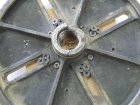How long does the screw have to penetrate into the wood to get a good hold? I realize that this depends upon the size of the blank I am turning but I hope to get a general rule of thumb.
At the moment I want to turn a 8" diameter by 1.5" thick blank as practice for platter turning. Finished platter would be about 1 to 1 1/4" thick.
At the moment I want to turn a 8" diameter by 1.5" thick blank as practice for platter turning. Finished platter would be about 1 to 1 1/4" thick.

